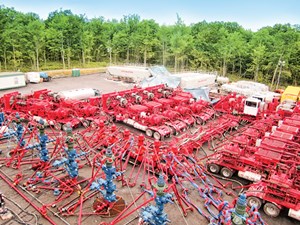Shale plays revolutionize U.S. production
Nothing epitomizes the 2001-2016 period more than the “Shale Revolution” in the U.S. First, there was a wave of shale gas development. But as gas prices flattened and crude prices continued to increase, the emphasis shifted to widespread development of shale oil, as well as the “wet” portions of gas-prone plays.
Accordingly, during the entire period, U.S. natural gas production grew 34.3%, from 67.1 Bcfd in 2001, to 90.1 Bcfd in 2015, including a low of 64.3 Bcfd in 2005 and a high of 92.0 Bcfd in February 2016. More impressively, U.S. oil production increased an astonishing 81.9%, from an average 5.184 MMbpd in 2005 to 9.431 MMbpd in 2015.
Some observers outside the industry think that shale activity’s two prominent features—horizontal drilling and hydraulic fracturing—are creations of the 1990s and early 2000s. Yet, as early as 1919, a patent application was filed in the U.S. for equipment designed to drill horizontal wellbores, and in 1929, the first horizontal laterals were drilled from a vertical oil well.

Similarly, the first experimental “hydrafrac” stimulation was performed in 1947 on a well in the Hugoton gas field in Grant County, Kan., using 1,000 gal of napalm-thickened gasoline by Stanolind Oil and Gas Corp. Five additional hydrafrac treatments were performed on wells at Rangley, Colo., that year, but all were considered to be failures. In 1949, a patent for hydrafrac treatment was issued to Halliburton Oil Well Cementing Co., and in 1956, Dowell completed (at the time) the “biggest frac job in history,” utilizing 250,000 gal of water, 200,000 lb of sand and 4,500 hp. Of course, these early efforts were not focused on shale formations and not performed on horizontal wells. It was not until the 1980s, in the Barnett shale, that the modern age of fracing began to take place.
Shale gas. The grand-daddy of U.S. shale plays is the Barnett, where groundbreaking work on effective fracing was done by Mitchell Energy. The firm discovered the field in 1982, in Wise County, Texas. Drilled vertically and completed with a nitrogen foam frac, the discovery well was not a prolific gas producer. Nevertheless, Mitchell persevered, convinced that Barnett gas could be produced with better methods. In 1986, Mitchell Energy applied the first massive gel frac, and then drilled the first horizontal Barnett well during 1991, but it was not successful. Not until 1998 did Mitchell drill two more horizontal holes, which were technical successes but economic failures.
Meanwhile, the Barnett’s largest technical breakthrough occurred in 1997, when Mitchell Energy experimented successfully with using a slickwater frac. It not only cut completion costs, but also resulted in more prolific gas production. Thus, the shale boom was on, and other operators took notice. In 2002, Mitchell Energy was sold to Devon Energy. Devon, along with Chesapeake Energy, accelerated the use of fracing in combination with horizontal wells. In 2008, 2,901 horizontal wells were completed in the Barnett, versus just 183 vertical wells.
Success in the Barnett was duplicated in several other shale gas plays, including the Fayetteville, Marcellus, Haynesville and Woodford. The prolific Marcellus was the main driving force behind the rapid growth in U.S. gas production between 2001 and 2015.
Shale oil. As the shale gas boom took off, North Dakota operators began looking at ways to adapt the use of horizontal drilling and fracing to exploit tight oil in the Bakken shale. Their efforts succeeded beyond expectations. By the peak of activity in 2010 to 2014, seven companies accounted for about two-thirds of activity, with Continental Resources leading the way. These operators boosted North Dakota’s oil output from 79,000 bpd in January 2004, to a high of 1.2 MMbpd in June 2015. Production has since fallen 100,000 bpd, due to the oil price downturn starting in late 2014.
Similarly, the 400-mi-long Eagle Ford shale fairway of South Texas, featuring liquids and dry gas in addition to oil, was dominated by four companies (Chesapeake, EOG, ConocoPhillips and Marathon Oil) that accounted for nearly half of all activity. The Eagle Ford was a major factor in tripling Texas oil production from a low of just over 1.0 MMbpd in 2004, to a high of 3.644 MMbpd in March 2015.
Additionally, in northern Colorado’s Niobrara shale, the largest player is still Noble Energy, with other top operators including WPX, Quicksilver and Devon Energy. Together, the Niobrara producers have increased Colorado’s oil production 625%, from 44,000 bpd in late 2001 to the current 319,000 bpd. Meanwhile, in the Permian basin of West Texas, several bountiful shales are producing in this historic, conventional oil basin. Exploitation of these shale layers has given new life to the region, and has contributed substantially to the higher Texas oil output figure. Despite the lower oil prices, the Permian basin remains the single-largest area of drilling activity in the U.S. Despite the downturn, the shale plays will remain a vital component of U.S. E&P activity, in the longer term. ![]()

- Applying ultra-deep LWD resistivity technology successfully in a SAGD operation (May 2019)
- Adoption of wireless intelligent completions advances (May 2019)
- Majors double down as takeaway crunch eases (April 2019)
- What’s new in well logging and formation evaluation (April 2019)
- Qualification of a 20,000-psi subsea BOP: A collaborative approach (February 2019)
- ConocoPhillips’ Greg Leveille sees rapid trajectory of technical advancement continuing (February 2019)


